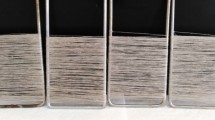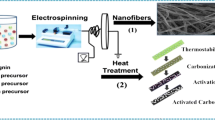Abstract
In this study, we utilized a multi-step stabilization method, incorporating dry-oxidation, to produce high-density polyethylene (HDPE)-based activated carbon fibers. This stabilization was achieved through electron-beam irradiation, sulfonation, and dry oxidation. The stabilized fibers were carbonized and activated at 900 ℃. The crystallite characteristics of the activated carbon fibers were observed using X-ray diffraction, and their surface morphologies were analyzed through scanning electron microscopy. The textural properties were analyzed using N2/77 K adsorption–desorption isothermal curves. And leveraging the microdomain model, we explored the influence of these stabilization methods on the HDPE-based activated carbon fibers texture properties. The results show that HDPE fibers treated with sulfonation only at 100 ℃ for 60 min were not sufficiently cross-linked and were completely decomposed during the carbonization stage. However, the sulfonated fibers treated with the new dry-oxidation process maintained their shapes and were successfully activated. The specific surface area of the resulting activated carbon fibers was as much as 2000 m2/g.




Similar content being viewed by others
Data availability
The data that support the findings of this study are available from the corresponding author upon reasonable request.
References
Qie Z, Zhang Z, Sun F et al (2019) Effect of pore hierarchy and pore size on the combined adsorption of SO2 and toluene in activated coke. Fuel 257:116090. https://doi.org/10.1016/j.fuel.2019.116090
Gao L, Li C, Li S et al (2019) Superior performance and resistance to SO2 and H2O over CoOx-modified MnOx/biomass activated carbons for simultaneous Hg0 and NO removal. J Chem Eng 371:781–795. https://doi.org/10.1016/j.cej.2019.04.104
Kim J, Lee B-K (2018) Enhanced photocatalytic decomposition of VOCs by visible-driven photocatalyst combined Cu-TiO2 and activated carbon fiber. Process Saf Environ Prot 119:164–171. https://doi.org/10.1016/j.psep.2018.07.026
Yang J, Ren S, Zhang T et al (2020) Iron doped effects on active sites formation over activated carbon supported Mn-Ce oxide catalysts for low-temperature SCR of NO. J Chem Eng 379:122398. https://doi.org/10.1016/j.cej.2019.122398
Li X, Zhang L, Yang Z et al (2020) Hydrophobic modified activated carbon using PDMS for the adsorption of VOCs in humid condition. Sep Purif Technol 239:116517. https://doi.org/10.1016/j.seppur.2020.116517
Ouzzine M, Romero-Anaya AJ, Lillo-Ródenas MA, Linares-Solano A (2019) Spherical activated carbons for the adsorption of a real multicomponent VOC mixture. Carbon 148:214–223. https://doi.org/10.1016/j.carbon.2019.03.075
Zhou K, Ma W, Zeng Z et al (2019) Experimental and DFT study on the adsorption of VOCs on activated carbon/metal oxides composites. J Chem Eng 372:1122–1133. https://doi.org/10.1016/j.cej.2019.04.218
Ma X, Yang L, Wu H (2021) Removal of volatile organic compounds from the coal-fired flue gas by adsorption on activated carbon. J Clean Prod 302:126925. https://doi.org/10.1016/j.jclepro.2021.126925
de Oliveira Ferreira ME, Vaz BG, Borba CE et al (2019) Modified activated carbon as a promising adsorbent for quinoline removal. Microporous Mesoporous Mater 277:208–216. https://doi.org/10.1016/j.micromeso.2018.10.034
Xiang Y, Xu Z, Wei Y et al (2019) Carbon-based materials as adsorbent for antibiotics removal: mechanisms and influencing factors. J Environ Manag 237:128–138. https://doi.org/10.1016/j.jenvman.2019.02.068
Roegiers J, Denys S (2019) CFD-modelling of activated carbon fibers for indoor air purification. J Chem Eng 365:80–87. https://doi.org/10.1016/j.cej.2019.02.007
Roegiers J, Denys S (2021) Development of a novel type activated carbon fiber filter for indoor air purification. J Chem Eng 417:128109. https://doi.org/10.1016/j.cej.2020.128109
Yan M, Rong Y, Wu F et al (2023) Micro-mesoporous graphitized carbon fiber as hydrophobic adsorbent that removes volatile organic compounds from air. J Chem Eng 452:139184. https://doi.org/10.1016/j.cej.2022.139184
Srivastava A, Singh M, Karsauliya K et al (2020) Effective elimination of endocrine disrupting bisphenol A and S from drinking water using phenolic resin-based activated carbon fiber: adsorption, thermodynamic and kinetic studies. Environ Nanotechnol Monit Manag 14:100316. https://doi.org/10.1016/j.enmm.2020.100316
Liu B, Du C, Chen JJ et al (2021) Preparation of well-developed mesoporous activated carbon fibers from plant pulp fibers and its adsorption of methylene blue from solution. Chem Phys Lett 771:138535. https://doi.org/10.1016/j.cplett.2021.138535
Won JS, Lee HR, Lee MJ et al (2020) Fabrication of activated carbon fibers with sheath-core, hollow, or porous structures via conjugated melt spinning of polyethylene precursor. Polymers 12:2895. https://doi.org/10.3390/polym12122895
Yue Z, Vakili A, Wang J (2017) Activated carbon fibers from meltblown isotropic pitch fiber webs for vapor phase adsorption of volatile organic compounds. J Chem Eng 330:183–190. https://doi.org/10.1016/j.cej.2017.07.150
Wang K, Song Y, Yan R et al (2017) High capacitive performance of hollow activated carbon fibers derived from willow catkins. Appl Surf Sci 394:569–577. https://doi.org/10.1016/j.apsusc.2016.10.161
Liao MD, Peng C, Hou SP et al (2020) Large-scale synthesis of nitrogen-doped activated carbon fibers with high specific surface area for high-performance supercapacitors. Energy Technol 8:1901477. https://doi.org/10.1002/ente.201901477
Kang S-H, Lee H-M, Kim K-W, Kim B-J (2023) Preparation and characterization of polyethylene-based activated carbon fibers stabilized at low temperatures. J Ind Eng Chem 121:401–408. https://doi.org/10.1016/j.jiec.2023.01.042
Robertson M, Güillen Obando A, Emery J, Qiang Z (2022) Multifunctional carbon fibers from chemical upcycling of mask waste. ACS Omega 7:12278–12287. https://doi.org/10.1021/acsomega.2c00711
Kim K-W, Lee H-M, Kang S-H, Kim B-J (2021) Synthesis and characterization of activated carbon fibers derived from linear low-density polyethylene fibers stabilized at a low temperature. Polymers 13:3918. https://doi.org/10.3390/polym13223918
Kang S-H, Kim K-W, Kim B-J (2021) Carbon fibers from high-density polyethylene using a hybrid cross-linking technique. Polymers 13:2157. https://doi.org/10.3390/polym13132157
Barton BE, Patton JT, Hukkanen EJ, Bernius MT (2017) Two-step sulfonation process for the conversion of polymer fibers to carbon fibers. US9816207B2. https://www.osti.gov/servlets/purl/1408915. Accessed 3 May 2023
Park SK, Choi DY, Choi D et al (2020) Influences of absorbed dose rate on the mechanical properties and fiber-matrix interaction of high-density polyethylene-based carbon fiber reinforced thermoplastic irradiated by electron-beam. Polymers 12:3012. https://doi.org/10.3390/polym12123012
Choi D, Yoo SH, Lee S (2019) Safer and more effective route for polyethylene-derived carbon fiber fabrication using electron beam irradiation. Carbon 146:9–16. https://doi.org/10.1016/j.carbon.2019.01.061
Kiradjiev KB, Nikolakis V, Griffiths IM et al (2020) A simple model for the hygroscopy of sulfuric acid. Ind Eng Chem Res 59:4802–4808. https://doi.org/10.1021/acs.iecr.9b06018
Kim D-W, Kim K, Ideta C-I et al (2021) Structural pore elucidation of super-activated carbon based on the micro-domain structure model. J Ind Eng Chem 101:186–194
Biscoe J, Warren BE (1942) An X-ray study of carbon black. J Appl Phys 13:364–371. https://doi.org/10.1063/1.1714879
Brunauer S, Emmett PH, Teller E (1938) Adsorption of gases in multimolecular layers. J Am Chem Soc 60:309–319. https://doi.org/10.1021/ja01269a023
Barrett EP, Joyner LG, Halenda PP (1951) The determination of pore volume and area distributions in porous substances. I. Computations from nitrogen isotherms. J Am Chem Soc 73:373–380. https://doi.org/10.1021/ja01145a126
Lee S-M, Lee S-H, Roh J-S (2021) Analysis of activation process of carbon black based on structural parameters obtained by XRD analysis. Crystals 11:153. https://doi.org/10.3390/cryst11020153
Vázquez-Santos MB, Geissler E, László K et al (2011) Comparative XRD, raman, and TEM study on graphitization of PBO-derived carbon fibers. J Phys Chem C 116:257–268. https://doi.org/10.1021/jp2084499
Lee H-M, Lee B-H, Park S-J et al (2019) Pitch-derived activated carbon fibers for emission control of low-concentration hydrocarbon. Nanomaterials 9:1313. https://doi.org/10.3390/nano9091313
Thommes M, Kaneko K, Neimark AV et al (2015) Physisorption of gases, with special reference to the evaluation of surface area and pore size distribution (IUPAC Technical Report). Pure Appl Chem 87:1051–1069. https://doi.org/10.1515/pac-2014-1117
Baek J, Shin H-S, Chung DC, Kim B-J (2017) Studies on the correlation between nanostructure and pore development of polymeric precursor-based activated hard carbons: II. Transmission electron microscopy and Raman spectroscopy studies. J Ind Eng Chem 54:324–331. https://doi.org/10.1016/j.jiec.2017.06.007
Lee H-M, An K-H, Chung D-C et al (2019) Comparison studies on pore development mechanisms of activated hard carbons from polymeric resins and their applications for electrode materials. Renew Energ 144:116–122. https://doi.org/10.1016/j.renene.2018.11.020
Kim D-W, Kil H-S, Nakabayashi K et al (2017) Structural elucidation of physical and chemical activation mechanisms based on the microdomain structure model. Carbon 114:98–105. https://doi.org/10.1016/j.carbon.2016.11.082
Kim D-W, Kil H-S, Kim J et al (2017) Highly graphitized carbon from non-graphitizable raw material and its formation mechanism based on domain theory. Carbon 121:301–308. https://doi.org/10.1016/j.carbon.2017.05.086
Acknowledgements
This research was supported by the Nano-Material Technology Development Program through the National Research Foundation of Korea (NRF) funded by the Ministry of Science and ICT (NRF-2019M3A7B9071501).
Author information
Authors and Affiliations
Corresponding authors
Ethics declarations
Conflict of interest
The authors declare that they have no known competing financial interests or personal relationships that could have appeared to influence the work reported in this paper.
Additional information
Publisher's Note
Springer Nature remains neutral with regard to jurisdictional claims in published maps and institutional affiliations.
Supplementary Information
Below is the link to the electronic supplementary material.
Rights and permissions
Springer Nature or its licensor (e.g. a society or other partner) holds exclusive rights to this article under a publishing agreement with the author(s) or other rightsholder(s); author self-archiving of the accepted manuscript version of this article is solely governed by the terms of such publishing agreement and applicable law.
About this article
Cite this article
Ahn, JR., Lee, HM. & Kim, BJ. Effects of multi-step stabilization method on textural properties of polyolefin-based activated carbon fibers. Carbon Lett. 34, 715–721 (2024). https://doi.org/10.1007/s42823-023-00614-z
Received:
Revised:
Accepted:
Published:
Issue Date:
DOI: https://doi.org/10.1007/s42823-023-00614-z




